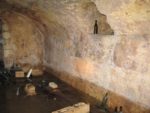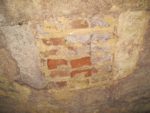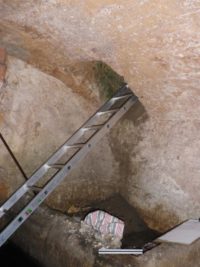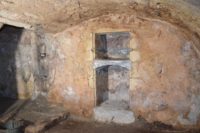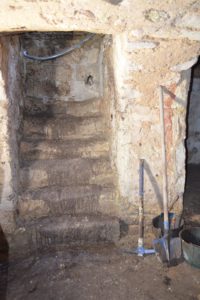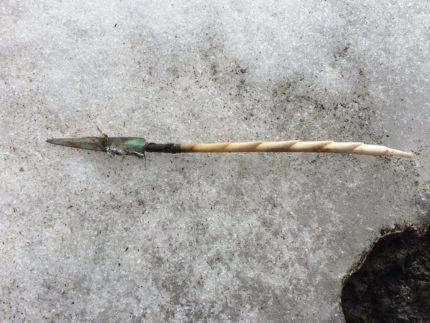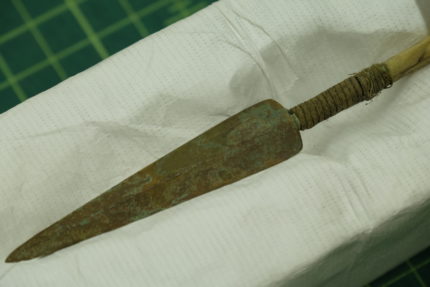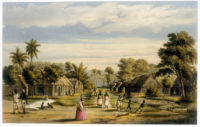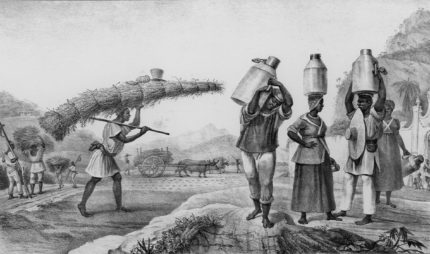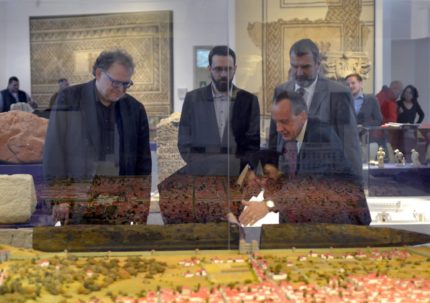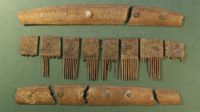 Archaeologists excavating the ancient market square in the city of Ribe in southwest Jutland, Denmark, have unearthed a comb from around 800 A.D. that is inscribed with the word “comb” written in runes. They also discovered a second runic inscription on a plaque of bone or antler that has yet to be deciphered.
Archaeologists excavating the ancient market square in the city of Ribe in southwest Jutland, Denmark, have unearthed a comb from around 800 A.D. that is inscribed with the word “comb” written in runes. They also discovered a second runic inscription on a plaque of bone or antler that has yet to be deciphered.
This is a sensational find, especially for Denmark. Runic inscriptions of any date are rare in Denmark; runes dating to the 9th century are exceptionally rare in Scandinavia period. Almost all of the runes from that period are carved on runestones, not inscribed on combs or bone plates. (Interestingly enough, the oldest Germanic language discovery ever made in central Germany were 3rd century runes also inscribed on a comb.)
So few runes have been found in Denmark that the discovery of two runic inscriptions from around 800 A.D. doubles the number of rune-engraved artifacts found in Ribe. The oldest extant town in Denmark, Ribe was already bustling in 793 A.D. when Viking raiders pillaged the monastery of Lindisfarne launching the Viking Era. Archaeologists have found evidence, however, of peaceful trade between the Norse of Norway and Denmark in Ribe. During an earlier dig season at the Ribe marketplace, antlers from Norwegian reindeer were found. They date to 725 A.D., which means the Norse were already taking on significant sea voyages and engaging in lucrative transactions with their neighbors long before the accepted date of the Viking Era.
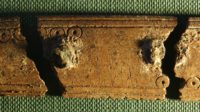 Given its history as a market city big enough to attract business from elsewhere in northern Europe, the comparative lack of runes on the archaeological record is puzzling. The runic alphabet was undergoing a seachange when Norsemen were trading reindeer antlers in Ribe, with the more complex Elder Futhark giving way to the newly succinct 16-letter Younger Futhark. The transition took place gradually over the 7th and 8th centuries, but by the early 9th, largely coinciding with the arrival of the Viking Era, the Younger had decisively overthrown the Elder. Researchers have been hoping to find more runes from this pivotal transition phase to shed new light on the transition to Younger Futhark and the role the towns played in the shift.
Given its history as a market city big enough to attract business from elsewhere in northern Europe, the comparative lack of runes on the archaeological record is puzzling. The runic alphabet was undergoing a seachange when Norsemen were trading reindeer antlers in Ribe, with the more complex Elder Futhark giving way to the newly succinct 16-letter Younger Futhark. The transition took place gradually over the 7th and 8th centuries, but by the early 9th, largely coinciding with the arrival of the Viking Era, the Younger had decisively overthrown the Elder. Researchers have been hoping to find more runes from this pivotal transition phase to shed new light on the transition to Younger Futhark and the role the towns played in the shift.
Archaeologists were especially interested to find out whether the script on the comb and plate were the new alphabet, which came into use at the beginning of the Viking Age.
Previously, the Vikings used a more complicated alphabet known as the 24 character futhark—itself a combination of the first six letters of the alphabet.
“It was built up so each rune had its own name and indicated the sound. But as the language developed, the names and sounds changed too, and in the end it was too difficult to remember the sound value of each rune and there was too much uncertainty in the message being conveyed,” says rune expert Lisbeth Imer from the National Museum of Denmark.
“At some point they decided not to use the old system anymore,” says Imer, who was invited to Ribe to study the two new discoveries and decipher whether it was the old or new alphabet.
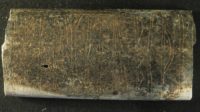 Imer found that both inscriptions were written in Younger Futhark, just the linguistic jackpot they were hoping for. The word “comb” in inscribed on both sides of the comb, although they are different parts of speech. The verb “to comb” is on one side, the noun “comb” on the other. The handwriting suggests the inscriptions may have been carved by two different people.
Imer found that both inscriptions were written in Younger Futhark, just the linguistic jackpot they were hoping for. The word “comb” in inscribed on both sides of the comb, although they are different parts of speech. The verb “to comb” is on one side, the noun “comb” on the other. The handwriting suggests the inscriptions may have been carved by two different people.
The runes on the bone plate are fragmentary — both ends are missing — and the piece was damaged by fire at some point making it even more difficult to read. It is clear that the text was engraved by one person, someone with a fine hand who could pull a proper line. He did not use the markers which denote the beginning and end of a word, so while the inscription is in theory decipherable, it’s difficult and experts haven’t cracked it quite yet.
Here’s Imer giving it a go in this video:




